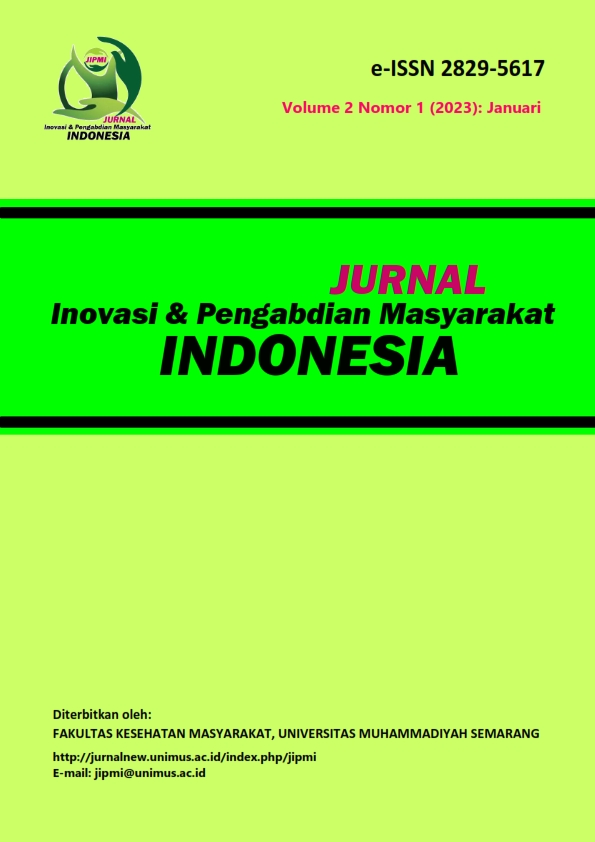Pelatihan Pembuatan Bolu Biji Hanjeli Kepada Masyarakat Kawasan Geopark Ciletuh, Kabupaten Sukabumi
DOI:
https://doi.org/10.26714/jipmi.v2i1.88Kata Kunci:
bolu, hanjeli, kawasan geopark, pengabdian masyarakat, rumah hanjeli indonesiaAbstrak
Latar belakang: Kawasan geopark Ciletuh memiliki potensi pangan lokal yang dikenal sebagai hanjeli. Hanjeli memiliki kadar pati dan karbohidrat yang tinggi, protein yang rendah dan komponen kalsium, maka hanjeli dinilai sangat baik untuk diolah menjadi bahan pangan. Penggunaan tepung bebas gluten untuk bahan pembuatan bolu sangat baik untuk penderita celiac dan intoleransi gluten. Tujuan: Kegiatan ini merupakan upaya untuk meningkatkan nilai ekonomi hanjeli dan meningkatkan pengetahuan masyarakat terhadap produk olahan hanjeli. Metode: Tim pengabdian masyarakat Program Studi Pendidikan Teknologi Agroindustri, Fakultas Pendidikan Teknologi dan Kejuruan, Universitas Pendidikan Indonesia bekerjasama dengan Rumah Hanjeli Indonesia telah membuat formulasi produksi bolu berbahan tepung hanjeli. Tim pengabdian memberikan pelatihan dan edukasi kepada masyarakat di sekitar Kawasan Geopark Ciletuh tentang pemanfaatan biji hanjeli dan potensi pengolahannya menjadi produk pangan yang dapat meningkatkan nilai ekonomi dari biji hanjeli. Hasil: Pembuatan bolu dengan tepung hanjeli dihadiri 12 peserta yang aktif bertanya dan berdiskusi selama pelatihan berlangsung. Kesimpulan: Transfer pengetahuan dan ketrampilan dalam pembuatan bolu dengan tepung hanjeli dapat dilakukan dengan baik. Ketrampilan yang diperoleh dapat dikembangkan lebih lanjut jika produksi akan ditingkatkan pada skala komersial.
Kata Kunci: bolu, hanjeli, kawasan geopark, pengabdian masyarakat, rumah hanjeli indonesia
__________________________________________________________________________________________
Abstract
Background: The Ciletuh Geopark area has a local food known as hanjeli. Hanjeli has high levels of starch and carbohydrates, low proteins, and calcium components, therefore, hanjeli is considered for food ingredient. The gluten-free flour for cake-making is beneficial for people with celiac and gluten intolerance. Objective: This training activity is to improve the community's knowledge of processed hanjeli products, the economic value of hanjeli flour, and the surrounding community's economy. Method: The community service team of the Agro-industrial Technology Education Study Program, Faculty of Technology and Vocational Education, Universitas Pendidikan Indonesia had created a formulation of cake production made from hanjeli flour. The community service team in collaboration with Rumah Hanjeli Indonesia provided education and training to the community around the Ciletuh Geopark Area about the utilization of hanjeli seeds and the food product processing that it can increase the economic value of hanjeli sources. Result: The training for making cakes with hanjeli flour was attended by 12 participants who actively asked questions and discussed. Conclusion: The transfer of knowledge and skills in making cakes with hanjeli flour has been done successfully. The skills acquired have to be further developed when the production is scaled up commercially.
Keywords: cake, hanjeli, geopark area, community service, rumah hanjeli indonesia
Referensi
Kemenparekraf. Desa Wisata Hanjeli. https://jadesta.kemenparekraf.go.id, https://jadesta.kemenparekraf.go.id/desa/hanjeli (accessed 18 November 2022).
Devaraj RD, Jeepipalli SPK, Xu B. Phytochemistry and health promoting effects of Job’s tears (Coix lacryma-jobi) - A critical review. Food Biosci 2020; 34: 100537.
Luithui Y, Kamani MH, Manchanahally M. Impact of hydrothermal processing on Job’s tears grain fractions and its protein isolates: Evaluation of digestibility, functionality, and anti-nutritional factors. J Food Process Preserv 2021; 45: e15636.
Luithui Y, Kamani MH, Sreerama YN, et al. Impact of hydrothermal processing on squalene, α-tocopherol, and fatty acid content in Job’s tears grain milled fractions: evaluation of their storage stability. J Sci Food Agric 2021; 101: 2319–2327.
Jomduang S, Bunthawong O. Optimal Pre-Treatment Processes for Microwavable Puffed Job’s Tears Grains. Chiang Mai Univ J Nat Sci 2019; 18: 107–121.
Siswanti T, Kurniawati N, Hapsariningsih W, et al. Pembuatan Glukosa Mengandung Kalsium dari Biji Jali (Coix Lachryma-Jobi L) untuk Mencegah Osteoporosis. In: Simposium Nasional RAPI XIII FT UMS. 2014, pp. 29–33.
Kutschera M, Krasaekoopt W. The use of job’s tear (Coix lacryma-jobi L.) flour to substitute cake flour in butter cake. AU J Technol 2012; 15: 233–238.
Wrigley C, Seetharaman K, Corke H, et al. (eds). Encyclopedia of Food Grains. 2nd ed. 2016.
Chaisiricharoenkul J, Tongta S, Intarapichet K-O. Structure and chemical and physicochemical properties of job’s tear (Coix lacryma-jobi L.) kernels and flours. Suranaree J Sci Technol 2011; 18: 109–122.
Andoy CJN, Enot IVR, Mabaza AJD, et al. Utilization of Job’s Tear (Coix Lacryma-Joba L.) Flour as Composite for All Purpose Flour in Saltine Crackers. Am J Biomed Life Sci 2019; 7: 52–56.
Dewandari KT, Munarso J, Rahmawati R. Sifat Fisikokimia Berondong Hanjeli (Coix lacryma-jobi L). J Penelit Pascapanen Pertan 2020; 17: 154–164.
Ottoboni LMM, Leite A, Targon MLN, et al. Characterization of the storage protein in seed of Coix lacryma-jobi var. Adlay. J Agric Food Chem 1990; 38: 631–635.
Niro S, D’Agostino A, Fratianni A, et al. Gluten-Free Alternative Grains: Nutritional Evaluation and Bioactive Compounds. FOODS; 8. Epub ahead of print 2019. DOI: 10.3390/foods8060208.
Han J (Jay), Janz JAM, Gerlat M. Development of gluten-free cracker snacks using pulse flours and fractions. Food Res Int 2010; 43: 627–633.
Kaur S, Kumar K, Singh L, et al. Gluten-free grains: Importance, processing and its effect on quality of gluten-free products. Crit Rev Food Sci Nutr 2022; 1–28.
Unduhan
Diterbitkan
Cara Mengutip
Terbitan
Bagian
Lisensi
Hak Cipta (c) 2023 JURNAL INOVASI DAN PENGABDIAN MASYARAKAT INDONESIA

Artikel ini berlisensi Creative Commons Attribution-NonCommercial 4.0 International License.
















